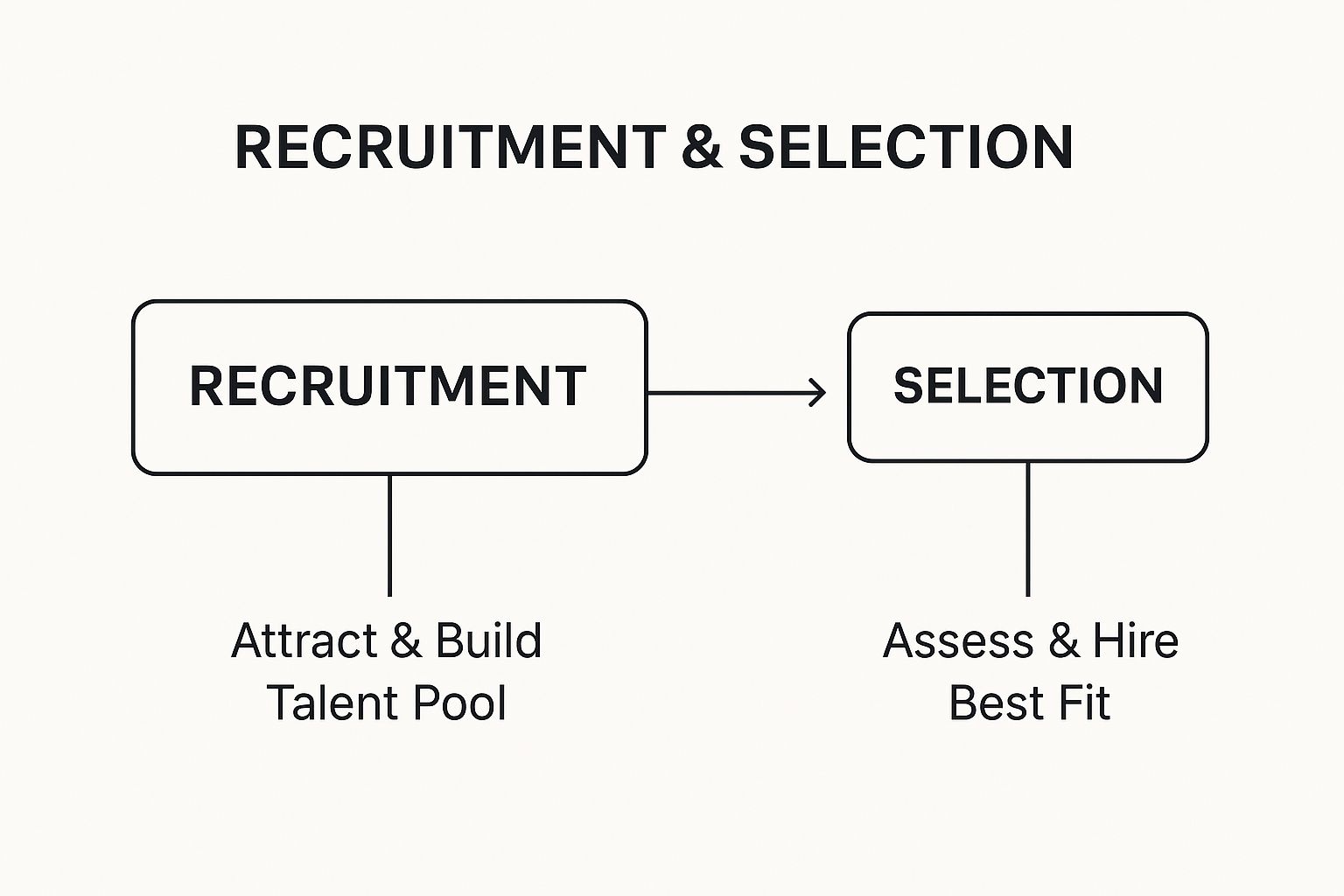A critical distinction between recruitment and selection lies in the stakeholder involvement.
Understanding the different players and their roles in each process is crucial for efficient and effective hiring, especially for CHROs overseeing the entire talent acquisition lifecycle.
This aspect significantly impacts how you structure your hiring process and allocate resources.
Recruitment and selection are distinct yet interconnected stages, each involving different stakeholders with varying responsibilities.
Recruitment focuses on attracting a large and diverse pool of potential candidates. This stage primarily involves HR professionals, recruiters, and marketing teams, often leveraging external agencies to expand reach. Their focus is on quantity and diversity, ensuring a wide net is cast to capture talent.
Selection, on the other hand, is the process of evaluating these candidates against specific job requirements and team fit to identify the best match. This stage involves hiring managers, departmental teams, and sometimes senior leadership or even clients. Their focus shifts to quality and fit assessment, ensuring the selected candidate possesses the required skills and aligns with the company culture.
The difference in focus, from quantity in recruitment to quality in selection, necessitates distinct stakeholder groups with specialized expertise.
For instance, recruitment stakeholders might leverage social media campaigns and job boards to reach a wider audience, while selection stakeholders will conduct technical interviews, assess cultural add and culture fitment, and perhaps even involve candidates in practical exercises relevant to the role.
Features of Stakeholder Involvement:
- Recruitment: Primarily involves HR, recruiters, and marketing professionals. Focuses on quantity and diversity of candidates.
- Selection: Involves hiring managers, potential colleagues, and sometimes customers or clients. Focuses on quality and fit assessment.
Pros of Distinct Stakeholder Involvement:
- Comprehensive Evaluation: Different perspectives ensure a well-rounded evaluation of candidates, considering both skillset and cultural fit.
- Specialized Roles: Allows for expertise in different aspects of the hiring process, optimizing both outreach and evaluation.
- Checks and Balances: The separation creates checks and balances, minimizing bias and ensuring a fair process.
Cons of Managing Multiple Stakeholders:
- Coordination Challenges: Managing communication and expectations across different stakeholder groups can be complex.
- Conflicting Priorities: Potential for conflicting priorities and assessment criteria between different stakeholders.
- Time Management: Involving multiple stakeholders in the selection process can lead to scheduling difficulties and extended timelines.
Examples of Successful Implementation:
- Zappos famously involves customer service representatives in the selection process, giving them a voice in choosing future colleagues, but not in the initial recruitment phase. This helps ensure new hires align with their customer-centric culture.
- Microsoft’s specialized technical recruitment team focuses on sourcing and attracting technical talent, distinct from the technical interview panels comprised of engineers and team leads who conduct the selection process.
Actionable Tips for CHROs:
- Clearly Defined Roles: Create clear role definitions and responsibilities for stakeholders in both recruitment and selection processes.
- Alignment Meetings: Hold joint meetings between recruitment and selection stakeholders to align expectations and assessment criteria.
- Targeted Training: Train hiring managers on their specific selection responsibilities, differentiating them from recruitment activities.
- Feedback Mechanisms: Develop feedback loops between stakeholder groups to continuously improve the hiring process.
Learn more about Stakeholder Involvement
Popularized by models such as Google’s hiring committee and Netflix’s “keeper test” approach, a clearly defined stakeholder involvement strategy is crucial for successful hiring. These approaches emphasize the importance of diverse perspectives in the selection process, further highlighting the critical role of stakeholder involvement.
This item deserves its place on this list because it directly impacts the efficiency, effectiveness, and fairness of the entire hiring process, a key concern for any CHRO in the IN region aiming to build high-performing teams.
Understanding the nuanced difference between recruitment and selection stakeholders allows for better resource allocation, streamlined processes, and ultimately, better hiring outcomes.
 />
/>







